Leadership in Business
VerifiedAdded on 2023/04/20
|7
|1348
|446
AI Summary
Leadership styles, more often than not, align with the personality type of individual leaders. The essay discusses various leadership styles and comparisons along with critical analysis of the same.
Contribute Materials
Your contribution can guide someone’s learning journey. Share your
documents today.
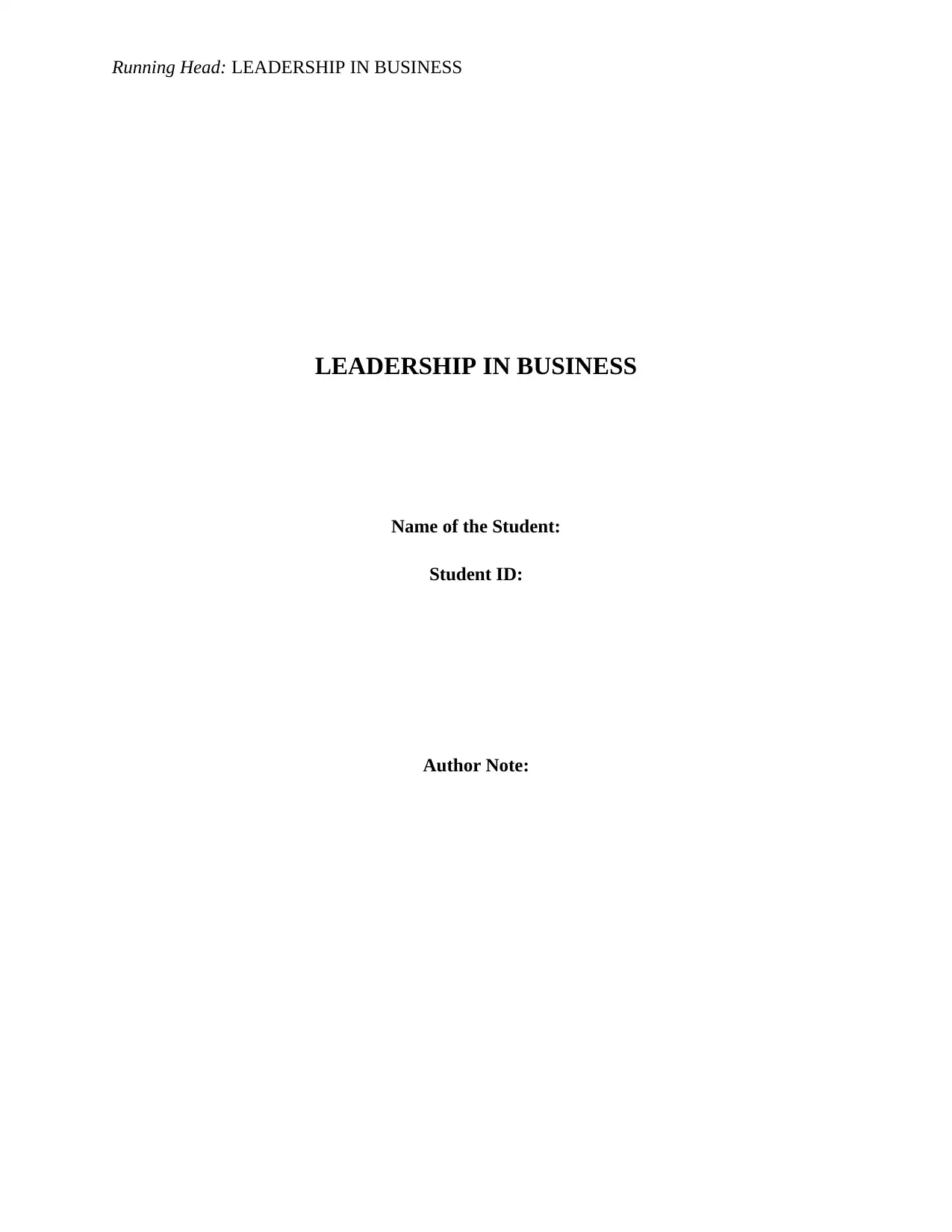
Running Head: LEADERSHIP IN BUSINESS
LEADERSHIP IN BUSINESS
Name of the Student:
Student ID:
Author Note:
LEADERSHIP IN BUSINESS
Name of the Student:
Student ID:
Author Note:
Secure Best Marks with AI Grader
Need help grading? Try our AI Grader for instant feedback on your assignments.
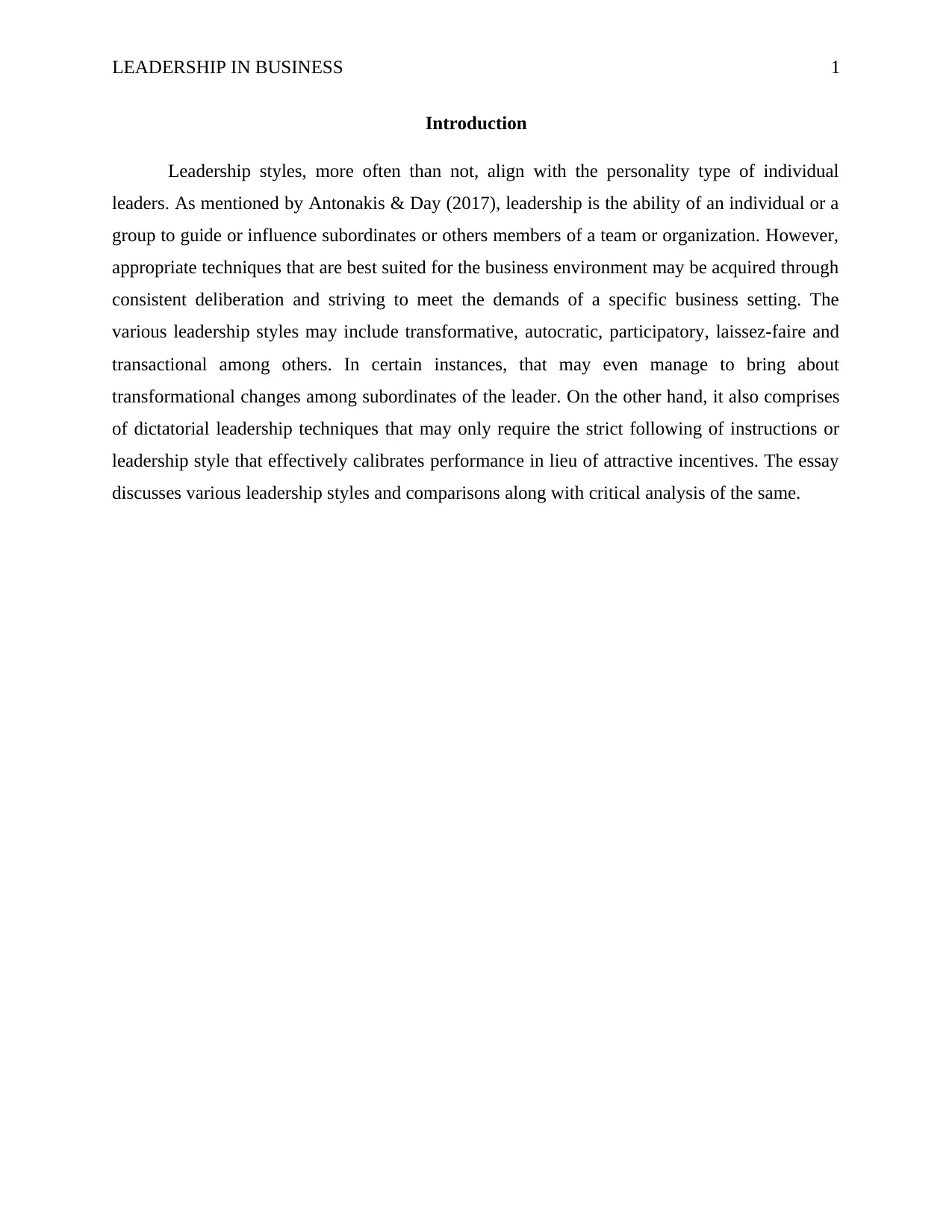
LEADERSHIP IN BUSINESS 1
Introduction
Leadership styles, more often than not, align with the personality type of individual
leaders. As mentioned by Antonakis & Day (2017), leadership is the ability of an individual or a
group to guide or influence subordinates or others members of a team or organization. However,
appropriate techniques that are best suited for the business environment may be acquired through
consistent deliberation and striving to meet the demands of a specific business setting. The
various leadership styles may include transformative, autocratic, participatory, laissez-faire and
transactional among others. In certain instances, that may even manage to bring about
transformational changes among subordinates of the leader. On the other hand, it also comprises
of dictatorial leadership techniques that may only require the strict following of instructions or
leadership style that effectively calibrates performance in lieu of attractive incentives. The essay
discusses various leadership styles and comparisons along with critical analysis of the same.
Introduction
Leadership styles, more often than not, align with the personality type of individual
leaders. As mentioned by Antonakis & Day (2017), leadership is the ability of an individual or a
group to guide or influence subordinates or others members of a team or organization. However,
appropriate techniques that are best suited for the business environment may be acquired through
consistent deliberation and striving to meet the demands of a specific business setting. The
various leadership styles may include transformative, autocratic, participatory, laissez-faire and
transactional among others. In certain instances, that may even manage to bring about
transformational changes among subordinates of the leader. On the other hand, it also comprises
of dictatorial leadership techniques that may only require the strict following of instructions or
leadership style that effectively calibrates performance in lieu of attractive incentives. The essay
discusses various leadership styles and comparisons along with critical analysis of the same.
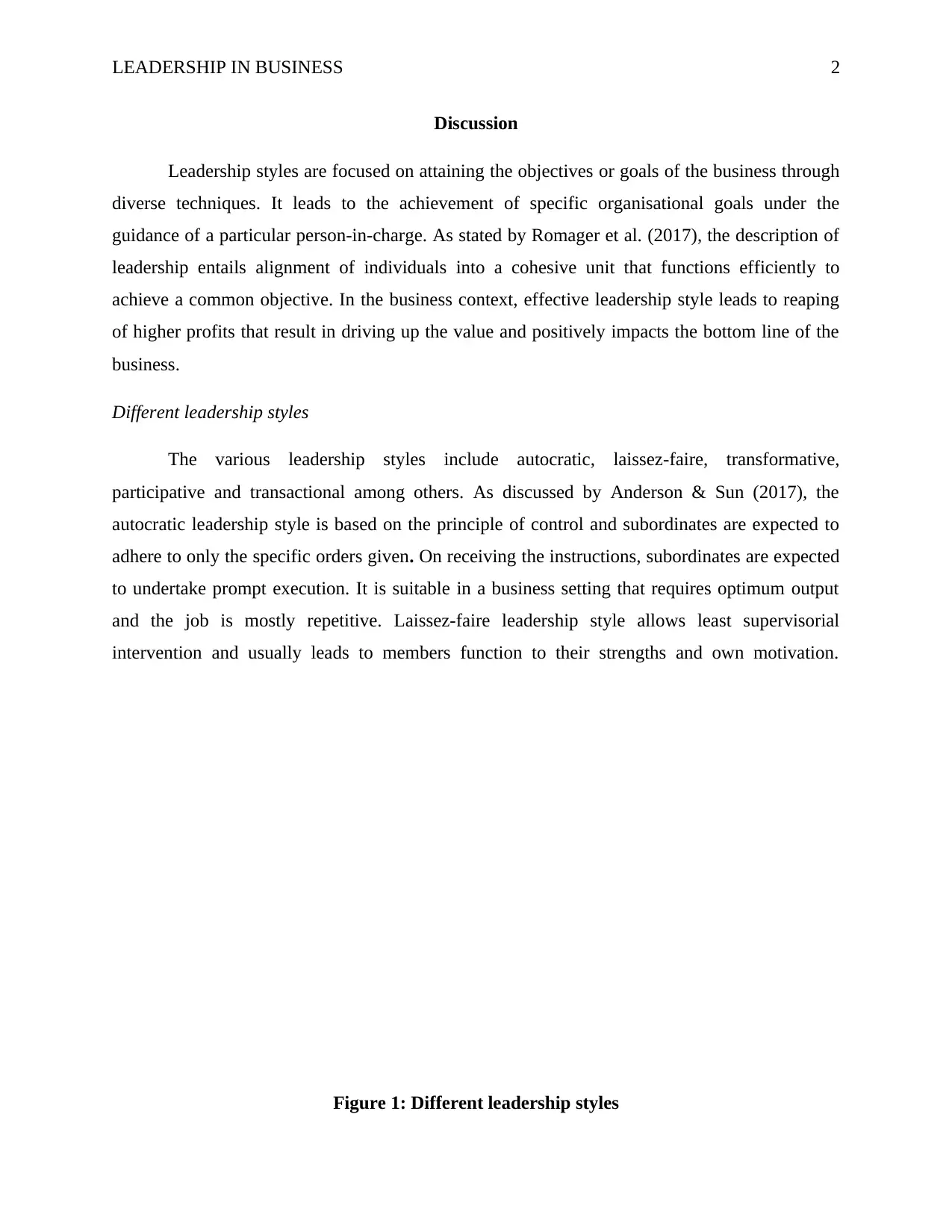
LEADERSHIP IN BUSINESS 2
Discussion
Leadership styles are focused on attaining the objectives or goals of the business through
diverse techniques. It leads to the achievement of specific organisational goals under the
guidance of a particular person-in-charge. As stated by Romager et al. (2017), the description of
leadership entails alignment of individuals into a cohesive unit that functions efficiently to
achieve a common objective. In the business context, effective leadership style leads to reaping
of higher profits that result in driving up the value and positively impacts the bottom line of the
business.
Different leadership styles
The various leadership styles include autocratic, laissez-faire, transformative,
participative and transactional among others. As discussed by Anderson & Sun (2017), the
autocratic leadership style is based on the principle of control and subordinates are expected to
adhere to only the specific orders given. On receiving the instructions, subordinates are expected
to undertake prompt execution. It is suitable in a business setting that requires optimum output
and the job is mostly repetitive. Laissez-faire leadership style allows least supervisorial
intervention and usually leads to members function to their strengths and own motivation.
Figure 1: Different leadership styles
Participant
Discussion
Leadership styles are focused on attaining the objectives or goals of the business through
diverse techniques. It leads to the achievement of specific organisational goals under the
guidance of a particular person-in-charge. As stated by Romager et al. (2017), the description of
leadership entails alignment of individuals into a cohesive unit that functions efficiently to
achieve a common objective. In the business context, effective leadership style leads to reaping
of higher profits that result in driving up the value and positively impacts the bottom line of the
business.
Different leadership styles
The various leadership styles include autocratic, laissez-faire, transformative,
participative and transactional among others. As discussed by Anderson & Sun (2017), the
autocratic leadership style is based on the principle of control and subordinates are expected to
adhere to only the specific orders given. On receiving the instructions, subordinates are expected
to undertake prompt execution. It is suitable in a business setting that requires optimum output
and the job is mostly repetitive. Laissez-faire leadership style allows least supervisorial
intervention and usually leads to members function to their strengths and own motivation.
Figure 1: Different leadership styles
Participant
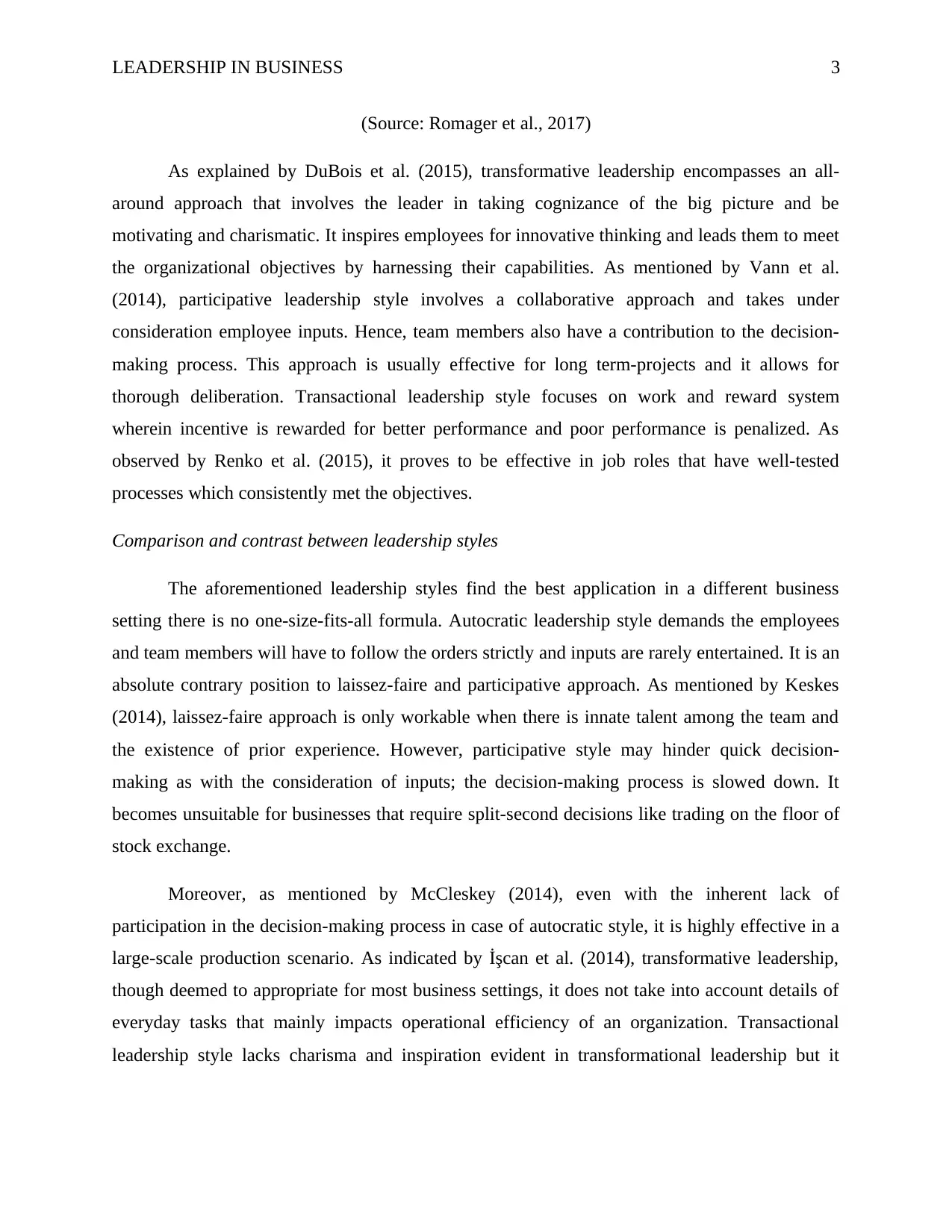
LEADERSHIP IN BUSINESS 3
(Source: Romager et al., 2017)
As explained by DuBois et al. (2015), transformative leadership encompasses an all-
around approach that involves the leader in taking cognizance of the big picture and be
motivating and charismatic. It inspires employees for innovative thinking and leads them to meet
the organizational objectives by harnessing their capabilities. As mentioned by Vann et al.
(2014), participative leadership style involves a collaborative approach and takes under
consideration employee inputs. Hence, team members also have a contribution to the decision-
making process. This approach is usually effective for long term-projects and it allows for
thorough deliberation. Transactional leadership style focuses on work and reward system
wherein incentive is rewarded for better performance and poor performance is penalized. As
observed by Renko et al. (2015), it proves to be effective in job roles that have well-tested
processes which consistently met the objectives.
Comparison and contrast between leadership styles
The aforementioned leadership styles find the best application in a different business
setting there is no one-size-fits-all formula. Autocratic leadership style demands the employees
and team members will have to follow the orders strictly and inputs are rarely entertained. It is an
absolute contrary position to laissez-faire and participative approach. As mentioned by Keskes
(2014), laissez-faire approach is only workable when there is innate talent among the team and
the existence of prior experience. However, participative style may hinder quick decision-
making as with the consideration of inputs; the decision-making process is slowed down. It
becomes unsuitable for businesses that require split-second decisions like trading on the floor of
stock exchange.
Moreover, as mentioned by McCleskey (2014), even with the inherent lack of
participation in the decision-making process in case of autocratic style, it is highly effective in a
large-scale production scenario. As indicated by İşcan et al. (2014), transformative leadership,
though deemed to appropriate for most business settings, it does not take into account details of
everyday tasks that mainly impacts operational efficiency of an organization. Transactional
leadership style lacks charisma and inspiration evident in transformational leadership but it
(Source: Romager et al., 2017)
As explained by DuBois et al. (2015), transformative leadership encompasses an all-
around approach that involves the leader in taking cognizance of the big picture and be
motivating and charismatic. It inspires employees for innovative thinking and leads them to meet
the organizational objectives by harnessing their capabilities. As mentioned by Vann et al.
(2014), participative leadership style involves a collaborative approach and takes under
consideration employee inputs. Hence, team members also have a contribution to the decision-
making process. This approach is usually effective for long term-projects and it allows for
thorough deliberation. Transactional leadership style focuses on work and reward system
wherein incentive is rewarded for better performance and poor performance is penalized. As
observed by Renko et al. (2015), it proves to be effective in job roles that have well-tested
processes which consistently met the objectives.
Comparison and contrast between leadership styles
The aforementioned leadership styles find the best application in a different business
setting there is no one-size-fits-all formula. Autocratic leadership style demands the employees
and team members will have to follow the orders strictly and inputs are rarely entertained. It is an
absolute contrary position to laissez-faire and participative approach. As mentioned by Keskes
(2014), laissez-faire approach is only workable when there is innate talent among the team and
the existence of prior experience. However, participative style may hinder quick decision-
making as with the consideration of inputs; the decision-making process is slowed down. It
becomes unsuitable for businesses that require split-second decisions like trading on the floor of
stock exchange.
Moreover, as mentioned by McCleskey (2014), even with the inherent lack of
participation in the decision-making process in case of autocratic style, it is highly effective in a
large-scale production scenario. As indicated by İşcan et al. (2014), transformative leadership,
though deemed to appropriate for most business settings, it does not take into account details of
everyday tasks that mainly impacts operational efficiency of an organization. Transactional
leadership style lacks charisma and inspiration evident in transformational leadership but it
Secure Best Marks with AI Grader
Need help grading? Try our AI Grader for instant feedback on your assignments.
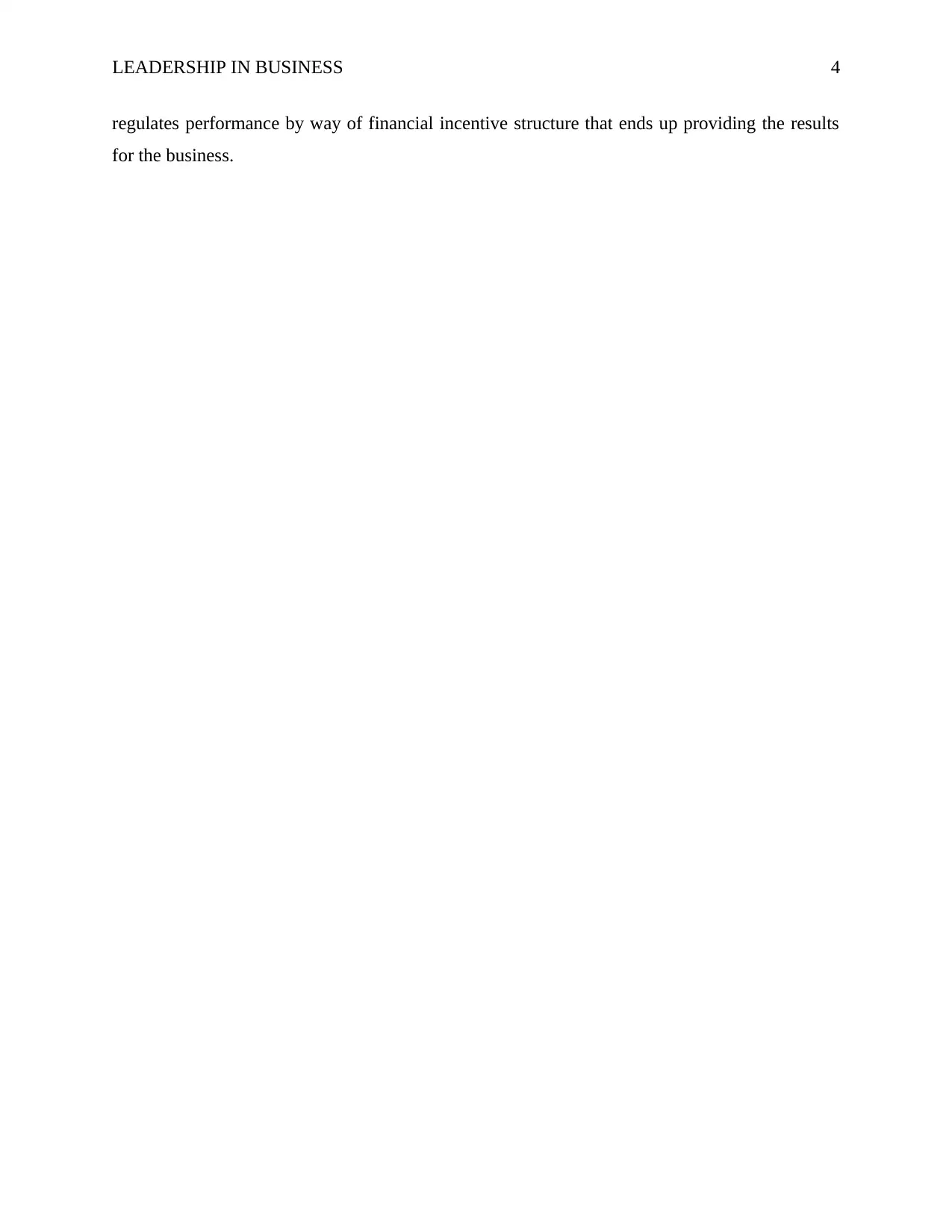
LEADERSHIP IN BUSINESS 4
regulates performance by way of financial incentive structure that ends up providing the results
for the business.
regulates performance by way of financial incentive structure that ends up providing the results
for the business.
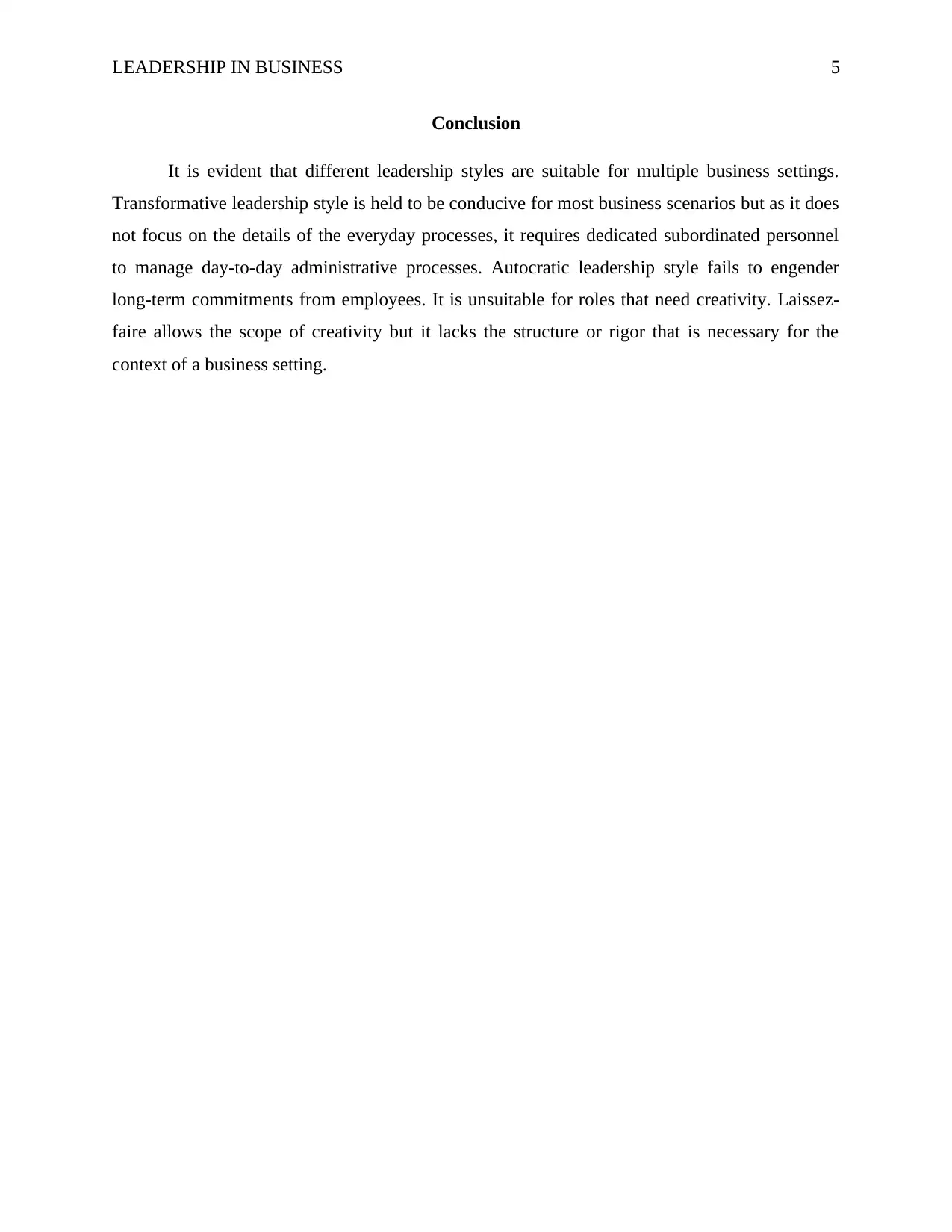
LEADERSHIP IN BUSINESS 5
Conclusion
It is evident that different leadership styles are suitable for multiple business settings.
Transformative leadership style is held to be conducive for most business scenarios but as it does
not focus on the details of the everyday processes, it requires dedicated subordinated personnel
to manage day-to-day administrative processes. Autocratic leadership style fails to engender
long-term commitments from employees. It is unsuitable for roles that need creativity. Laissez-
faire allows the scope of creativity but it lacks the structure or rigor that is necessary for the
context of a business setting.
Conclusion
It is evident that different leadership styles are suitable for multiple business settings.
Transformative leadership style is held to be conducive for most business scenarios but as it does
not focus on the details of the everyday processes, it requires dedicated subordinated personnel
to manage day-to-day administrative processes. Autocratic leadership style fails to engender
long-term commitments from employees. It is unsuitable for roles that need creativity. Laissez-
faire allows the scope of creativity but it lacks the structure or rigor that is necessary for the
context of a business setting.
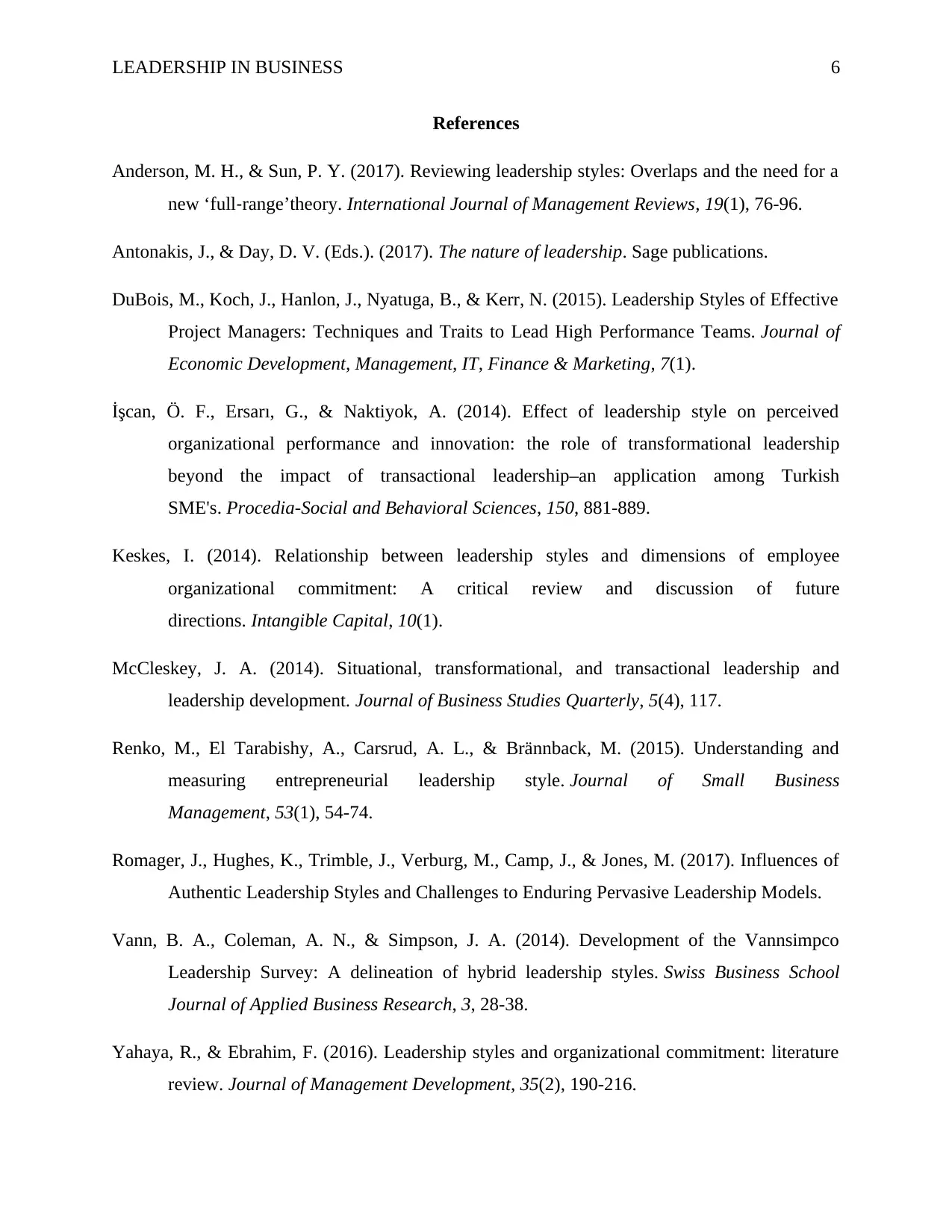
LEADERSHIP IN BUSINESS 6
References
Anderson, M. H., & Sun, P. Y. (2017). Reviewing leadership styles: Overlaps and the need for a
new ‘full‐range’theory. International Journal of Management Reviews, 19(1), 76-96.
Antonakis, J., & Day, D. V. (Eds.). (2017). The nature of leadership. Sage publications.
DuBois, M., Koch, J., Hanlon, J., Nyatuga, B., & Kerr, N. (2015). Leadership Styles of Effective
Project Managers: Techniques and Traits to Lead High Performance Teams. Journal of
Economic Development, Management, IT, Finance & Marketing, 7(1).
İşcan, Ö. F., Ersarı, G., & Naktiyok, A. (2014). Effect of leadership style on perceived
organizational performance and innovation: the role of transformational leadership
beyond the impact of transactional leadership–an application among Turkish
SME's. Procedia-Social and Behavioral Sciences, 150, 881-889.
Keskes, I. (2014). Relationship between leadership styles and dimensions of employee
organizational commitment: A critical review and discussion of future
directions. Intangible Capital, 10(1).
McCleskey, J. A. (2014). Situational, transformational, and transactional leadership and
leadership development. Journal of Business Studies Quarterly, 5(4), 117.
Renko, M., El Tarabishy, A., Carsrud, A. L., & Brännback, M. (2015). Understanding and
measuring entrepreneurial leadership style. Journal of Small Business
Management, 53(1), 54-74.
Romager, J., Hughes, K., Trimble, J., Verburg, M., Camp, J., & Jones, M. (2017). Influences of
Authentic Leadership Styles and Challenges to Enduring Pervasive Leadership Models.
Vann, B. A., Coleman, A. N., & Simpson, J. A. (2014). Development of the Vannsimpco
Leadership Survey: A delineation of hybrid leadership styles. Swiss Business School
Journal of Applied Business Research, 3, 28-38.
Yahaya, R., & Ebrahim, F. (2016). Leadership styles and organizational commitment: literature
review. Journal of Management Development, 35(2), 190-216.
References
Anderson, M. H., & Sun, P. Y. (2017). Reviewing leadership styles: Overlaps and the need for a
new ‘full‐range’theory. International Journal of Management Reviews, 19(1), 76-96.
Antonakis, J., & Day, D. V. (Eds.). (2017). The nature of leadership. Sage publications.
DuBois, M., Koch, J., Hanlon, J., Nyatuga, B., & Kerr, N. (2015). Leadership Styles of Effective
Project Managers: Techniques and Traits to Lead High Performance Teams. Journal of
Economic Development, Management, IT, Finance & Marketing, 7(1).
İşcan, Ö. F., Ersarı, G., & Naktiyok, A. (2014). Effect of leadership style on perceived
organizational performance and innovation: the role of transformational leadership
beyond the impact of transactional leadership–an application among Turkish
SME's. Procedia-Social and Behavioral Sciences, 150, 881-889.
Keskes, I. (2014). Relationship between leadership styles and dimensions of employee
organizational commitment: A critical review and discussion of future
directions. Intangible Capital, 10(1).
McCleskey, J. A. (2014). Situational, transformational, and transactional leadership and
leadership development. Journal of Business Studies Quarterly, 5(4), 117.
Renko, M., El Tarabishy, A., Carsrud, A. L., & Brännback, M. (2015). Understanding and
measuring entrepreneurial leadership style. Journal of Small Business
Management, 53(1), 54-74.
Romager, J., Hughes, K., Trimble, J., Verburg, M., Camp, J., & Jones, M. (2017). Influences of
Authentic Leadership Styles and Challenges to Enduring Pervasive Leadership Models.
Vann, B. A., Coleman, A. N., & Simpson, J. A. (2014). Development of the Vannsimpco
Leadership Survey: A delineation of hybrid leadership styles. Swiss Business School
Journal of Applied Business Research, 3, 28-38.
Yahaya, R., & Ebrahim, F. (2016). Leadership styles and organizational commitment: literature
review. Journal of Management Development, 35(2), 190-216.
1 out of 7
Related Documents
Your All-in-One AI-Powered Toolkit for Academic Success.
+13062052269
info@desklib.com
Available 24*7 on WhatsApp / Email
![[object Object]](/_next/static/media/star-bottom.7253800d.svg)
Unlock your academic potential
© 2024 | Zucol Services PVT LTD | All rights reserved.




